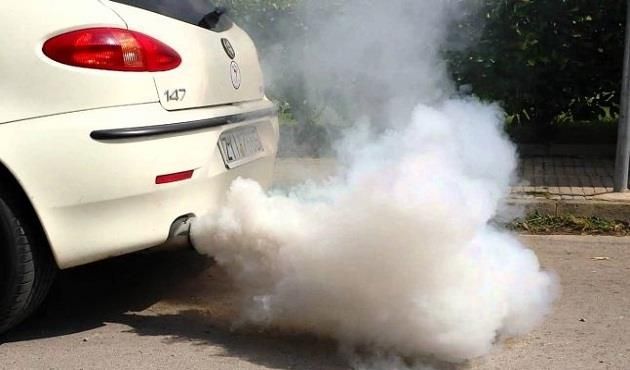Why Is My Car Smoking From Exhaust? — A Friendly Repair Guide 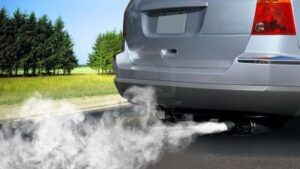
Welcome to technicalreader.com .If you’ve ever glanced at your tailpipe and thought, “Uh-oh — why is my car smoking from exhaust?” — you’re not alone. It’s one of those instantly alarming car issues that makes any driver’s heart skip a beat. When you notice smoke, the first question that pops up is exactly this: why is my car smoking from exhaust, and what does it mean for my vehicle?
Don’t worry — you’re about to find out. In this complete guide, we’ll break down everything you need to know about why is my car smoking from exhaust, including what different smoke colors mean, how sensors can trigger it, and what quick fixes might save your engine. Whether it’s white smoke, blue smoke, or black smoke, we’ll help you figure out why is my car smoking from exhaust and what steps you should take next.
This guide is written in plain English, with real-world troubleshooting tips — just like I’d explain to a friend in the driveway. Ready to uncover why is my car smoking from exhaust and how to solve it for good? Let’s dive in!
Quick overview: color matters
First rule: the color of the smoke tells most of the story.
-
White smoke (thin / vapor-like) — usually steam (water vapor). Often harmless in small amounts (condensation) but can signal coolant burning if it’s thick and persistent.
-
White smoke (thick, sweet smell) — coolant entering the combustion chamber. Big red flag: head gasket, cracked block, or intake manifold leak.
-
Blue-gray smoke — burning oil. Could be worn rings, valve seal issues, or turbo problems on turbocharged cars.
-
Black smoke — too much fuel / rich mixture. Faulty injectors, bad sensors, clogged air intake, or turbo ove rfuelling.
From here on, we’ll dig into each color, but since your keyword is “why is my car smoking from exhaust”, I’ll focus on the most common and urgent causes (white smoke), then cover the others and answer the common “people also search” questions at the end.
White smoke — what it normally means (and what it can hide)
1) Condensation — often harmless
If the smoke is thin, short-lived, and disappears as the engine warms, especially on cold mornings, it’s usually just water vapor from condensation in the exhaust. This is normal.
Signs: light mist, disappears after warm-up, no loss of coolant, no overheating, no sweet smell.
2) Burning coolant — the serious kind
If the white smoke is thick, persistent, and has a sweet smell, it’s likely coolant entering the combustion chamber. Causes include:
-
Blown head gasket — the classic culprit. A blown gasket can allow coolant to leak into cylinders.
-
Cracked cylinder head or engine block — physical damage that mixes coolant and combustion.
-
Intake manifold gasket leak (on engines where coolant flows through intake).
-
Leaking cooling system component that makes its way into the engine (rare but possible).
Signs to watch for:
-
Continuous dense white smoke from the exhaust.
-
Sweet, syrupy smell from the tailpipe.
-
Sudden or gradual coolant loss (check radiator / overflow tank).
-
Engine overheating or unexplained temperature rise.
-
Bubbles in the coolant reservoir or radiator with engine running.
3) Fuel-related white smoke
Less common: in diesel engines, white smoke during start can be unburned fuel (bad glow plugs, cold start issues). In petrol cars, fuel mixture problems usually produce black smoke. 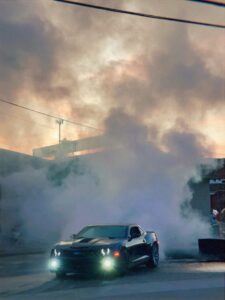
Blue / gray smoke — burning oil
If the smoke is blue- gray, your engine is probably burning oil. Causes include:
-
Worn piston rings (oil leaking past rings into combustion chamber).
-
Worn or hardened valve stem seals (oil leaking into cylinders when parked).
-
Worn turbocharger seals (in turbo cars — oil leaks into intake/exhaust).
-
Overfilled engine oil (yes, too much oil can cause smoking).
Signs:
-
Blue- smoke on acceleration or constant idling.
-
Oil level dropping between services.
-
Smoky smell and oily deposits in the exhaust tip.
Black smoke — too much fuel
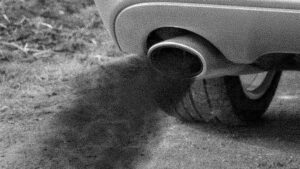
Black smoke means the engine is running rich — more fuel than air is being burned. Causes:
-
Faulty fuel injectors (stuck open or leaking).
-
Bad Mass Air Flow (MAF) sensor or O₂ sensor sending wrong readings.
-
Clogged air filter or intake — not enough air, so the ECU adds more fuel.
-
Faulty fuel pressure regulator.
-
Turbocharger problems (in diesel/turbo petrol cars).
Signs:
-
Strong fuel smell.
-
Black sooty smoke especially under acceleration.
-
Poor fuel economy.
First steps — what to check right away (safety first)
When you notice smoke: stop and assess. Don’t guess.
-
Is it safe to keep driving?
-
If smoke is thin and goes away after warm-up → probably okay for a short drive.
-
If smoke is thick, persistent, accompanied by overheating, loss of coolant, or strong sweet smell → don’t drive. Tow it. You risk severe engine damage.
-
-
Check coolant and oil levels immediately.
-
Rapid coolant loss + white smoke = probable coolant entering cylinders.
-
Lower oil + blue smoke = oil burning problem.
-
-
Smell test (carefully):
-
Sweet/syrupy → coolant.
-
Oily → burning oil.
-
Gasoline/fuel smell → rich mixture.
-
-
Check for warning lights:
-
Temperature, check engine (CEL), oil pressure lights — heed them.
-
-
Look for external leaks:
-
Puddles under the car (coolant is often colored green/red/orange and has a sweet smell).
-
-
Note when the smoke occurs:
-
Cold start only? During acceleration? Continuous? This helps pinpoint cause.
-
Diagnostic checks you can do (basic tools, some patience)
If you’re comfortable with basic checks, this will help you narrow the problem before a mechanic visit.
Compression test
A low compression on one or more cylinders suggests head gasket failure or a cracked head/block.
Cylinder leak-down test
Shows where compression is escaping — into coolant passages (head gasket), crankcase (rings), or exhaust (valve).
Check spark plugs
Plug color can tell a story:
-
Wet, oily plug → oil burning.
-
White deposits → lean condition or coolant burning (overheating).
-
Black and sooty → rich condition.
Coolant pressure test
Pressurize cooling system and watch for pressure loss or external leaks; can also reveal a head gasket leak into combustion by observing bubbles.
Exhaust gas test in coolant
A chemical test (combustion leak tester) checks for combustion gases in the coolant—positive test strongly indicates head gasket or cracked head.
Sensors — can a sensor cause white smoke?
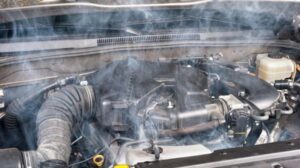
Short answer: rarely directly. Most sensors don’t cause white smoke by themselves. However, sensors can lead the engine control system into running conditions that may indirectly cause soot/smoke:
-
MAF / O₂ (oxygen) sensor issues usually cause black smoke (rich mixture), not white.
-
Coolant temperature sensor giving incorrect readings could make ECU over-fuel/under-fuel on cold start, but it won’t make coolant enter the cylinder.
-
EGR valve stuck can cause smoke (usually black or gray), not the white coolant-smoke scenario.
So when people ask “What sensor can cause white smoke?”, the practical answer is: sensors generally don’t cause true white smoke caused by burning coolant. True white exhaust smoke that smells sweet is almost always a mechanical breach between coolant and combustion (gasket, crack), not an electronic sensor fault.
Does white smoke always mean head gasket?
No — but it’s on the top of the suspect list. White exhaust smoke often indicates coolant is being burned, and the head gasket is the most common cause — especially if accompanied by overheating or coolant loss. But there are other possibilities:
-
Cracked cylinder head or block (from overheating or freezing).
-
Intake manifold gasket leak (on engines where coolant flows through the intake).
-
Faulty coolant passages in engines (less common).
-
Transmission fluid entering engine (rare, on some automatics with bad vacuum modulator).
So: white smoke doesn’t always mean head gasket, but don’t ignore it — treat it as an urgent diagnostic.
Can I drive my car if it’s blowing white smoke?
This question gets asked a lot. My practical answer:
-
If it’s light, only on a cold start, and stops after warm-up → you can probably drive carefully.
-
If it’s thick, continuous, accompanied by overheating, coolant loss, or engine misfire → don’t drive it. Towing is safer. Driving can cause catastrophic damage (warped head, seized engine).
When in doubt — stop driving and get a tow. Prevents a small repair from becoming a total engine replacement.
How do I stop white smoke from exhaust when I accelerate?
That depends on the cause:
-
If it’s condensation — nothing to do; it’ll stop as the car warms up.
-
If it’s coolant burning (head gasket/crack) — you need a repair: head gasket replacement, head machining, or block repair. Temporary additives exist (head gasket sealers), but they are hit-or-miss and usually a stop-gap. Best long-term fix = proper mechanical repair.
-
If it’s a clogged PCV or other valve issue causing oil ingestion — fix PCV, replace seals/valves, change oil, and smoke will reduce.
-
If it’s turbo oil seal failure — turbo repair or replacement.
So the way to stop white smoke when you accelerate is to address the underlying mechanical cause — shortcuts rarely fix the root problem.
Preventive tips — keep smoke away
-
Maintain cooling system: Regular coolant changes, replace hoses, thermostat and water pump as recommended.
-
Use quality oil and change it on schedule.
-
Don’t ignore overheating or low coolant. That’s often how head gaskets fail.
-
Avoid over-revving a cold engine.
-
Regular tune-ups: good spark, good fuel injection, and clean filters prevent black smoke.
-
Check turbochargers annually (if present) — turbo seals that leak oil will cause blue smoke.
When to see a mechanic — and what to expect
If you’ve got persistent white or blue smoke, a mechanic will typically:
-
Perform a compression and leak-down test.
-
Pressure-test the cooling system.
-
Check for combustion gases in the coolant (block test).
-
Inspect spark plugs, oil, and coolant condition.
-
Scan for fault codes (even if CEL isn’t on).
Repairs can range from minor (PCV valve, valve seals, turbo service) to major (head gasket, head machining, block repair). Cost varies widely by engine and region — but head gasket jobs are typically several hundred to a few thousand USD depending on labor and parts.
Short checklist you can follow right now
-
Park safely. Inspect smoke color and smell carefully.
-
Check coolant and oil levels. Top up only if safe.
-
If smoke is white and thick or you’re losing coolant — stop driving. Tow to a shop.
-
If smoke is blue and oil is disappearing — get it serviced (possible rings/valves/turbo).
-
If smoke is black and fuel economy is bad — check air filter, injectors, sensors Conclusion
If your question is “why is my car smoking from exhaust?”, the first step is to look at the color of the smoke and perform a few quick checks. Understanding why is my car smoking from exhaust can help you spot early warning signs before they turn into expensive repairs. Don’t ignore it — figuring out why is my car smoking from exhaust could save your engine from major damage. And if you notice thick white smoke or coolant loss, stop driving immediately. Take a moment to diagnose why is my car smoking from exhaust and get it inspected by a mechanic before things get worse.

